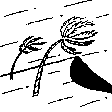

The Vallerani implement is a modified plow, pulled by a heavy-duty tractor. First, contour lines are marked on the slope. The tractor follows a contour line, and the plow makes a furrow about 50 cm deep. A normal plow on flat land excavates a symmetrical furrow, and earth piles up equally on both sides of the furrow. The Vallerani plow creates an angled furrow and piles up the excavated soil only on the lower (downhill) side. This soil forms a ridge that stops or slows down runoff water as it flows downhill.
The plow can dig a long continuous furrow. Alternatively, as it moves forward, the plow blade can also move up and down (i.e. in and out of the soil), creating a series of small basins, each with a ridge. The size and spacing of basins will depend on the frequency of the up-and-down movement of the plow, which can be adjusted.
When a furrow or pit fills up, the overflow enters the next microcatchment, flows into the next furrow or pit, and so on. Shrubs are planted in pits along the ridges. With moisture readily available, they grow rapidly, providing livestock fodder and helping to conserve the soil. The furrows/basins also slow down runoff flows, preventing erosion.
The Vallerani plow can ‘treat’ 30 ha in a single day, building scores of micro-catchments. For example, the 100-ha Qaryatein site, a highly degraded area at the center of the Syrian traditional grazing ground with 120 mm rainfall per year, was developed in 4 days. Preparation of pits and transplantation of shrubs took another 15 days. Once the project had invested in the tractor and the plow, the remaining cost of implementation – layout, planting shrubs, training farmers to build and maintain the system – was about US$1250, i.e. about $13 per hectare.
Location: Italy
No. of Technology sites analysed:
Spread of the Technology: evenly spread over an area
In a permanently protected area?:
Date of implementation: 10-50 years ago
Type of introduction











| Specify input | Unit | Quantity | Costs per Unit (n.a.) | Total costs per input (n.a.) | % of costs borne by land users |
| Labour | |||||
| layout, planting shrubs, training farmers to build and maintain the system | ha | 1.0 | 13.0 | 13.0 | 100.0 |
| Total costs for establishment of the Technology | 13.0 | ||||
| Total costs for establishment of the Technology in USD | 13.0 | ||||